Our top picks
Best Overall: Aeyla Dual Pillow
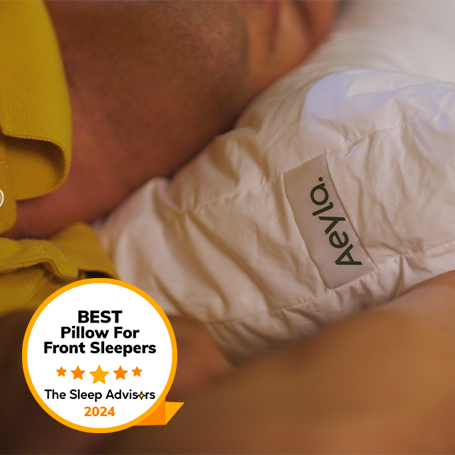
At first glance, the Aeyla Dual Pillow might seem too big for a front sleeper. So, how can we give it the award for the best pillow for front sleepers if it will snap your head backwards?
Well, looks can be decieving! That's because the Aeyla Dual Pillow is actually made up of two separate pillows. And while the loft is pretty big when they're together, individually, each one is perfect for front sleepers!
You can either go for the “core” pillow if you want a bit more support or use the outter layer for extra softness. Regardless of which option you choose, you will find that the pillow is remarkably fluffy. And the cotton covers are both nice to the touch and make the pillow a bit more breathable.
Plus, the pillow is both hypoallergenic and eco-friendly, which is always nice to hear.
If you'd like to know more, we suggest you read our full review of the Aeyla Dual Pillow.
- Size: 70 x 50 cm
- Cover: Cotton
- Firmness: Adjustable
- Type: Microfibre
- Filling: Virgin polyester
- Loft : Adjustable
Advantages



Disadvantages


Best Memory Foam: Emma Original Pillow
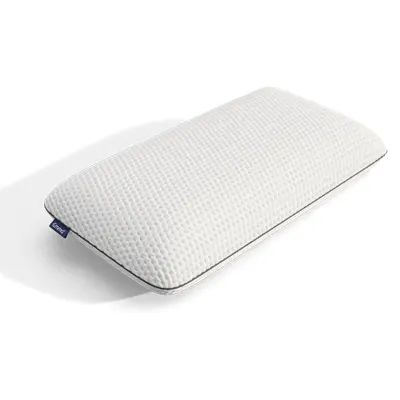
The Emma Original pillow provides a rare level of adjustability. It's not just about 3 removable layers to get the desired loft. Each of those three layers is different, so by combining 2 of the 3 or using one, you get exactly the kind of pillow you want.
Whichever combination you decide on, you can count on support and pressure relief.
Breathability and temperature regulation are just fine for a memory foam pillow. The polyester cover is removable and machine washable, making this pillow perfect for people with allergies. And it's one of the few pillows that comes with a 30-night trial.
However, if sustainability is at the top of your priority list, then you may want to consider another product from our list.
If you'd like to learn more, you can read our full review of the Emma Original Pillow.
- Size: 45 x 70 cm
- Cover: Cotton and polyester
- Firmness: Adjustable
- Type: Classic
- Filling: Memory foam
- Loft: Adjustable
Advantages



Disadvantages


Best Fully Adjustable: Simba Hybrid Pillow
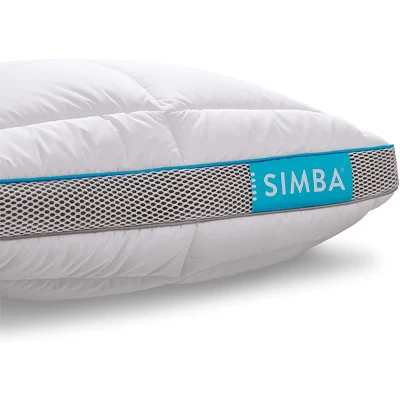
While we've featured adjustable pillows already, the Simba Hybrid Pillow is the best of the best in this department. And that's because you can adjust the loft of the pillow down to the millimetre!
The pillow has a specific structure so that every person can make it comfortable. You can add or remove Nanocubes until you get the perfect loft and firmness.
Open-cell foam Nanocubes and the mesh border make it highly breathable, and the space-inspired Stratos technology regulates the temperature and keeps you cool.
That's why this is the perfect pillow for hot sleepers. We also recommend it to allergy sufferers due to the hypoallergenic cover – which leads us to the conclusion that it is suitable for 99.9% of customers.
Although memory foam is not a sustainable material, the rest of this pillow is sustainable because the Better Cotton Initiative (BCI) cotton and other eco-friendly materials are used. Simba is well-known for its sustainability efforts.
Do check our in-depth review on Simba Hybrid pillow.
- Size: 45 x 70 cm
- Cover: Cotton and polyester
- Firmness: Adjustable
- Type: Hybrid
- Filling: Memory foam Nanocubes
- Loft: Adjustable
Advantages



Disadvantages


Best Value: Emma Premium Microfibre Pillow
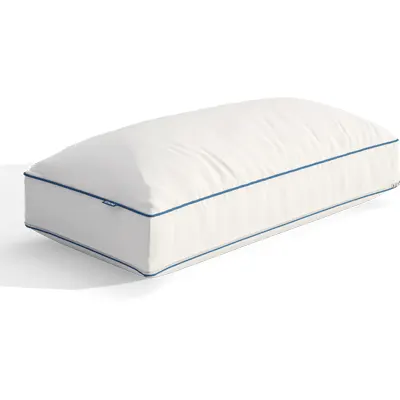
We believe that adjustable pillows will make up over 50% of the offer on the UK market within 10 years. The ability to adjust the loft and firmness is by far the best option, no matter how well a certain pillow suits you. We don't have the same needs every night.
This microfiber pillow actually consists of two pillows that are encased in a polyester cover, and you can use just one pillow or both.
They are supposed to have different firmness, but the difference is too small to notice. The siliconised elastic polyester fiber filling is very responsive, comfortable, and pressure relieving.
The UltraDry cover wicks moisture away, something that is especially important for hot sleepers. Since the Emma Premium Microfibre pillow is 100% made of polyester, this means that it is hypoallergenic, but also that sustainability is not its strong point.
It comes with a 2-year warranty and a 30-night trial. Kudos to Emma for giving a trial period.
If you'd like to learn more, you can read our full review of the Emma Premium Microfibre Pillow.
- Size: 50 x 70 cm
- Cover: Cotton and polyester
- Firmness: Adjustable
- Type: Classic
- Filling: 100% Polyester, hollowfibre
- Loft: Adjustable
Advantages



Disadvantages

Best Upgrade Pick: Simba Hybrid Firm Pillow
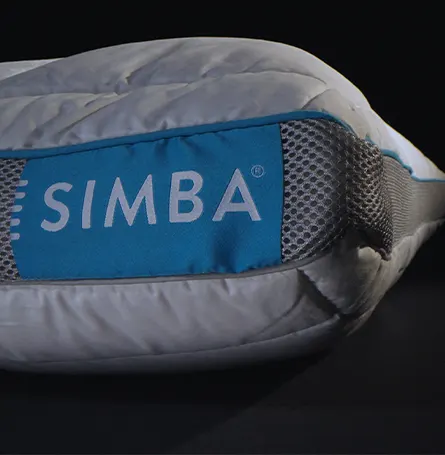
No, we didn't accidentaly put the Simba Hybrid Pillow on here twice! In fact, the Firm version is quite different from the original.
That's because, just like the Emma Microfibre Pillow, it contains premade pillow inserts that you can swap in and out. And, in this case, you're getting two soft and one firm insert.
So, already you get a level of adjustability, as you can try out the different inserts on their own or together. Plus, the firm insert is rather uniqe in the pillow world, as it contains tiny springs. So, in terms of support, it's unbeatable – especially for front sleepers!
On top of that, it still has some of the best features from the original – like a nice, soft cover that can keep you cool during even the hottest summer nights.
So, while it's fairly expensive, you can rest assured that you're getting the very best.
If you'd like to know more, you can read our full review of the Simba Hybrid Firm Pillow.
- Size: 45 x 70 cm
- Cover: 100% cotton with Stratos technology
- Firmness: Adjustable
- Type: Hybrid
- Filling: 00% polyurethane with aerocoil spring layer (firm layer), 100% polyester (soft layers)
- Loft: Adjustable
Advantages
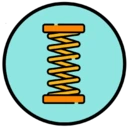


Disadvantages

What to consider when buying pillows for front sleepers
Firmness and loft are by far the two most important characteristics of any pillow, and this is especially the case when buying a pillow for a front sleeper. So we will start with those two features before moving on to materials and other topics of interest.
Level of firmness
If you've read several guides about pillows for front sleepers before visiting The Sleep Advisors, you've probably come across a lot of conflicting advice. Some recommend a soft pillow for stomach sleepers, while others say you should absolutely buy a firm one.
So what is the truth? Well, it's a bit complicated. We usually recommend firm pillows for front sleepers. The reason behind this is very simple. If you choose the appropriate loft, which in this case is low, then you need a firm pillow to always keep your head and neck in the same position.
However, if you do not want a low loft pillow, but rather a mid-loft or even a high one, then choosing among soft pillows is a better idea. After all, a soft pillow will allow your head to sink and get to an appropriate height. Thus, spinal alignment will be possible even with a soft, high-loft pillow.
With all of that being said, which is the better option? We think that a firm pillow is a lot “easier” to get right. This is because you don't have to take compression into account and can choose a pillow that fits you perfectly with ease. However, we think quite a few front sleepers would prefer a soft pillow when it comes to comfort. So, decide what's more important to you – comfort or ease of purchase.
Spinal & neck alignment
Now we come to the most important feature – the loft. When we talk about loft, you have to know that different manufacturers, sellers and reviewers refer to the term loft differently. While for some loft is a synonym for height, for others loft is the compressed height of the pillow when your head is resting on it, which is certainly a more accurate definition.
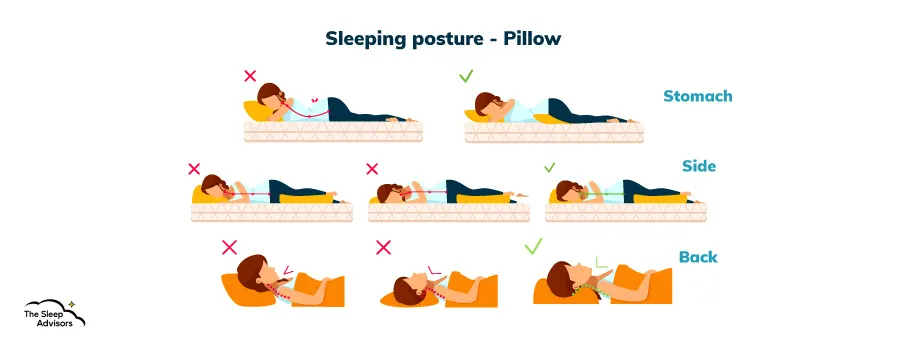
All in all, front sleepers need a low loft/height. In case you buy a soft pillow, which we talked about in the previous paragraph, then the height will be different, but the loft must be low. This is the only way spinal alignment is possible in this sleep position.
And it's pretty easy to understand why if you think about it. Unlike with side sleepers, there isn't a significant gap between your head and neck and the pillow. So, if the pillow is too big, your neck has to bend upwards to accommodate the pillow. And since this is the equivalent of going around with a crooked neck all day, neck pain is bound to crop up. The same applies to back sleepers, although it's a bit more forgiving.
Material
When you see what material the pillow is made of, you can conclude at least some basic characteristics. Today, there are so many different materials and their combinations on the market that you can certainly find exactly what suits you.
Memory foam is the most popular material, but many manufacturers use other polyester and natural materials as well. The best memory foam pillow is pressure relieving, supportive and comfortable, which is why it is so popular. Those who want similar characteristics, but for the material to be sustainable, should choose natural latex. Other common synthetic materials are microfibre and hollowfibre. Wool, bamboo, and cotton are just a few of the many natural materials that you can find both as a cover and as a core.
But that's just a general overview. To ensure that you know what to look for when finding the best pillows for front sleepers, we want to go into more detail. So, let's break it down one by one and see what they have to offer.
Memory foam pillows
As we've mentioned, memory foam pillows are generally the most popular pillow types. They're typically rather soft and can compress a bit. So, when it comes to the loft, make sure when compressed, the right pillow for you won't put strain on your neck. And, even if it says it's a medium firmness pillow, see how much it actually compresses.
It's also worth keeping in mind that a memory foam pillow can have slight overheating issues. So, if you're a hot sleeper, you could end up rather sweaty. Therefore, if you plan to go with traditional memory foam, cover all of your bases and get a breathable bamboo cover or something similar.
But overall, as long as you get the loft right and you balance out the breathability issues, most stomach sleepers should be satisfied with their memory foam pillows.
Down pillows
Down pillows are in a similar category as memory foam pillows since they're softer pillows that can compress quite a bit. However, down pillows typically compress even more than memory foam pillows. So, getting a flat pillow can be a bit more difficult in this case.
That being said, the pillows are incredibly comfortable. This is especially true if you can get a Hungarian goose-down pillow. And, in terms of comfort, this is going to be quite a good selling point regardless of your sleep style.
So, if you're thinking of getting a down pillow, we'd recommend searching for a Hungarian goose-down pillow, compressing it a bit, and trying to gauge whether it's flat enough. Down generally has a lot of give so it shouldn't be too difficult. And try to sleep at the edge of the pillow. This is because if your head is in the middle, the sides can prop up and block your mouth.
Latex pillows
If a memory foam pillow sounds pretty good but you'd also like a firmer pillow, latex could be your best bet. And that's because latex and memory foam share quite a few qualities. Most importantly, latex offers the same hugging sensation as a memory foam pillow. Plus, if you're looking for a medium-firm pillow or even a firm pillow, it's a lot easier to find if you switch to latex.
However, latex doesn't make any pillow the best pillow. After all, natural latex can still be rather expensive. And in terms of variety, you can find 100 memory foam pillows for every natural latex pillow. So, do keep that in mind.
Synthetic pillows
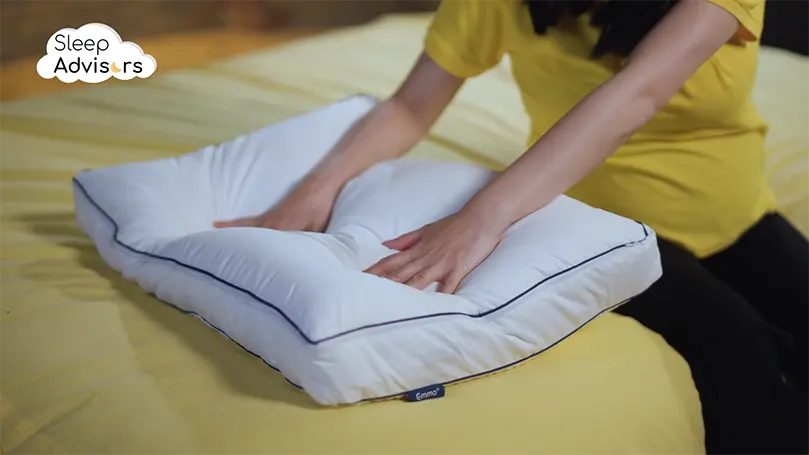
When we say synthetics, we mostly mean a hollow fibre filling. They're typically the cheapest, easy to find, and are available in many different firmness options. They're not always going to be a premium pillow but microfibre pillows aren't also that bad.
They usually don't compress as much as down, however, so even a medium loft pillow could be a bit too much. And they can have some breathability issues, especially if you pair them with a microfibre cover. But that differs from pillow to pillow. For example, once you step into microfibres, such as the Emma pillow, the quality is a lot higher.
Wool pillows
When it comes to pillows for front sleepers, wool could just be your ticket to a restful night's sleep. That's because a wool filling is typically pretty sturdy and firm. And this means that getting a flat pillow isn't as difficult. Plus, wool is one of the best fillings when it comes to temperature regulation. And there are plenty of higher-end brands that offer wool pillows.
So, for some, it might just be the best firm pillow on the market. However, do keep in mind that this isn't a budget pillow and that you could be allergic to wool. So, it's not as clear of a victory.
Hybrid pillows
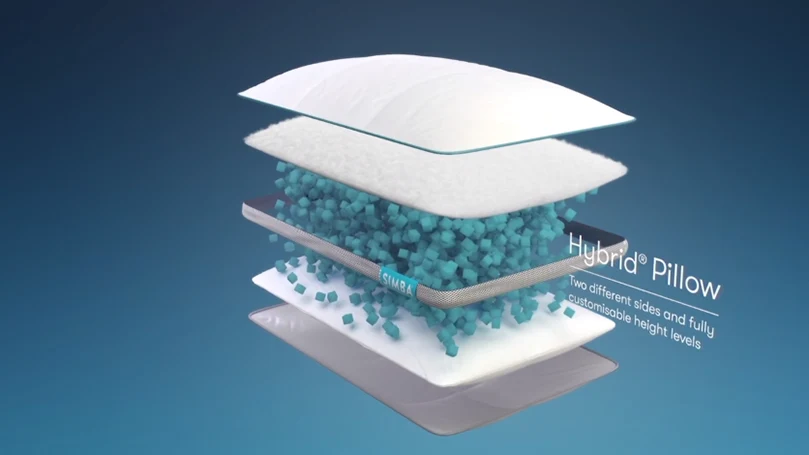
We're going to conclude our material pillow talk with hybrid pillows. We're going to keep it short, however, as hybrid pillows are anything but common. In fact, only one pillow we've featured falls under this category and it's the Simba pillow. But while it's not too common, it's quite the show-stealer.
After all, you can adjust the pillow to fit your needs perfectly. So, side sleepers and stomach sleepers alike can get some proper rest! Not to mention that Simba also has slight variants to this pillow, such as the Simba Hybrid Firm pillow. So, you really can get the perfect model for you.
Although, a Simba pillow is anything but cheap. And some people might prefer a different filling, or even a different approach to breathability, such as in the Panda pillow. So, we're not going to call it perfect, although it's definitely great.
Allergies
About one in three people in the UK has some form of allergy. This implies that allergy sufferers are a huge group of customers and therefore they are in the spotlight of the manufacturers. Which material, how it is processed, and maintenance play a role in whether a certain pillow will be hypoallergenic or not.
All synthetic materials are hypoallergenic, as well as natural materials such as cotton, eucalyptus, bamboo and buckwheat. Feather, down, and wool are also often hypoallergenic if they are processed in the right way and if the person does not have an allergy to that specific material. If you do not maintain the pillow, it is certain that allergens such as dust mites will accumulate and cause problems even for those who do not have allergies. Therefore, look for fully washable pillows or those with a removable, washable cover. Pillowcase can also be a solution to the problem.
Cooling & breathability
Cooling and breathability are features that hot sleepers will check first. If the pillow is made of single black of traditional foam, it is almost certain that it retains heat. Natural materials are way more cooling and breathable than synthetic ones.
However, it's worth keeping in mind that pillows have gotten a lot more advanced in this area. Some pillows, like the Panda Hybrid pillow, infuse memory foam with bamboo in order to amp the breathability and keep you cool and comfortable. Most latex pillows use pinholes in order to keep the air moving. Some hybrid pillows have air vents. And so on.
The main point being that even a memory foam pillow can be a cooling pillow. So, as long as you do your research, any pillow type can potentially be a decent choice in this category.
The cover
A lot of people tend to overlook pillow covers. However, a solid cover can make quite a difference and solidify certain pillows as the best pillows! For example, even if the pillow itself is breathable, the pillow covers are still “in the front lines”. So, if you're using a microfibre cover, you could still end up sweaty in the morning even if you have a cooling pillow.
Plus, both pillow covers and duvet covers come with some nice perks. Since they're in direct contact with your skin, they can help or hinder quite a bit in terms of certain conditions. For example, bamboo bedding or silk bedding can help you get the beauty sleep that you need. This is because the fibres are a lot finer and thus less likely to cause skin irritation.
As a bonus, we'd also like to mention pillow protectors. After all, if you want you keep your best pillows in tip-top shape for a long time, a pillow protector can help you achieve that goal!
What to do if you are a combination sleeper
Before we end off this section, we want to talk about combination sleepers. In case you didn't know, this just means that you change your sleeping position throughout the night. And the truth is, most people techically are combination sleepers, as the average person changes position about 10-40 times a night.
However, most people typically have a preferred sleeping position. And that position is what we refer to as your main sleeping position. However, just so that we're all on the same page, let's quickly discuss which pillow suits which sleeping style.
This is so that you can potentially find a healthy medium in case you think you swap positions even more frequently.
Side sleepers
When you're sleeping on your side, your shoulders make a gap between your neck and the pillow. So, you typically want a pillow with a high loft that can cover that area and keep your head and neck straight. And while a bit of cradling is appreciated, you don't want the pillow to compress too much.
So, a memory foam pillow would make for a solid choice here. However, any pillow that can support your head without compressing too much is solid. So, if a memory foam pillow isn't to your liking, a latex or synthetic pillow will do the job.
And, as you might've noticed, this is quite different than for stomach sleepers. So, it can be difficult to find a pillow that perfectly suits both styles.
Back sleepers
Like with stomach sleepers, back sleepers don't have a gap between their head and the pillow. So, the best pillow for them shouldn't have a very big loft. However, since your head is tilting forwards and not to the side, the chances of neck pain developing are a bit lower and are usually less severe.
So, if you happen to flip from your stomach to your back during the night, your best pillow shouldn't be too difficult to find. Just keep the loft low and it should suit both positions.
Tips for buying and using the best pillows for front sleepers
When buying a pillow, check if it comes with a trial period. This is not often the case, at least compared to mattresses. Most manufacturers believe that it is not necessary for the pillow to have a trial period. But if you find one like that, it will make your purchase much easier. It will practically make the purchase risk-free.
Pillows for front sleepers need maintenance like any other pillow. Wash it regularly if possible, and if not, make sure to wash the cover and/or pillowcase every few days. Anyone with skin problems, such as acne, should change pillowcase on daily basis. That’s the only way to sleep on surface free of allergens, dead skin cells and other dirt.
- The best choice you can make as a front sleeper is to buy a firm, low loft pillow
- Try not to put your arm under the pillow. It is not recommended for any sleep position, especially for stomach sleeping
- Maintain the pillow regularly because it can be a source of allergies, infections, and other health problems because you spend a third of the day on it and have close contact with it.
The advantages of owning the best pillows for front sleepers
The importance of pillows in general is so great that we would need a whole separate article to list all the advantages of owning pillows for front sleepers. Proper position of the head, neck, spine, and thus the rest of the body is the main advantage of a good pillow. As front sleeping is quite tricky for your neck, you must have a perfect mattress and pillow. Of course, we must not forget to mention comfort because sleeping is not only a matter of healthy joints and muscles. The pillow should be so comfortable that you don't want to get out of bed.
One of the advantages of pillows that is often overlooked is healthy and clean facial skin. The most sensitive skin is on our face. If you would sleep only on bed sheets that are dirty, pimples, acne, and other skin conditions would appear.
- Spinal alignment throughout the night
- Good night's sleep
- No allergies and skin problems.
Conclusion
In conclusion, selecting the ideal pillow for stomach sleepers is crucial to ensure optimal comfort and spinal alignment. Pillows with low loft, exceptional support, and breathable materials, such as memory foam or down alternatives, prove to be the top choices. We hope our selection of best pillows for front sleepers has made you the process of selection a bit easier!
Spread the word
FAQs about the best pillows for front sleepers UK
Before we say that sleeping on stomach is not that bad as some people present it, we want to say you need to follow a couple of tips to ensure you good night's sleep. In addition, we've prepared some of frequently asked questions about pillows for stomach sleepers.
Front sleepers should go with a low loft pillow.
There is no one best/worst material for pillows for front sleepers. It is rather about firmness and loft than specific material. Every material can be suitable/unsuitable.
Memory foam is good choice for those front sleepers who suffer from neck pain because foam relieves pressure.


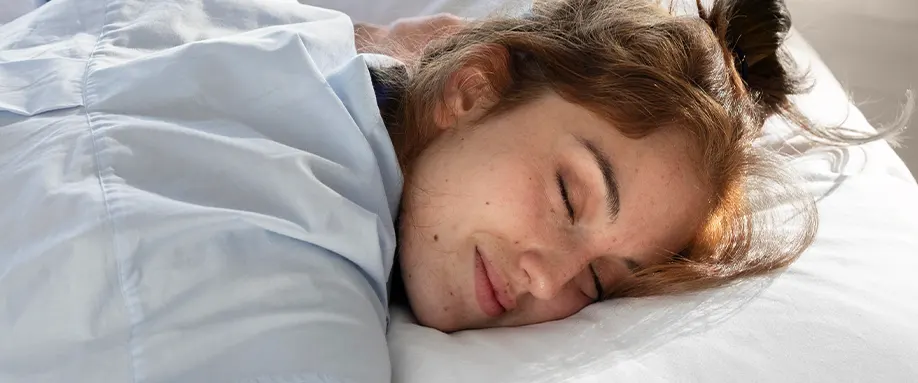
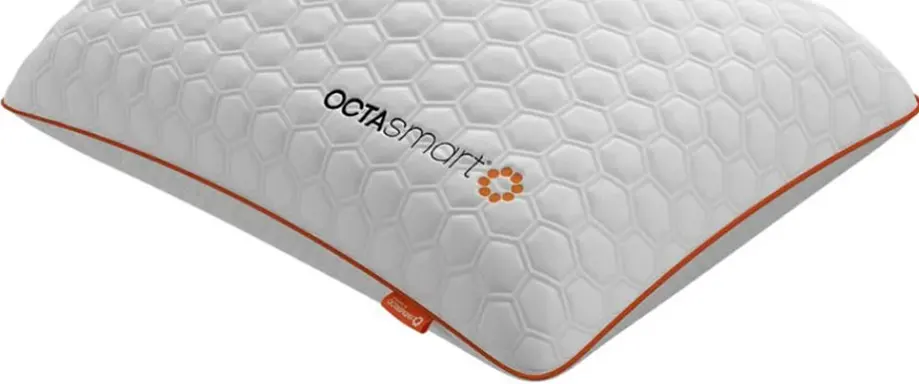
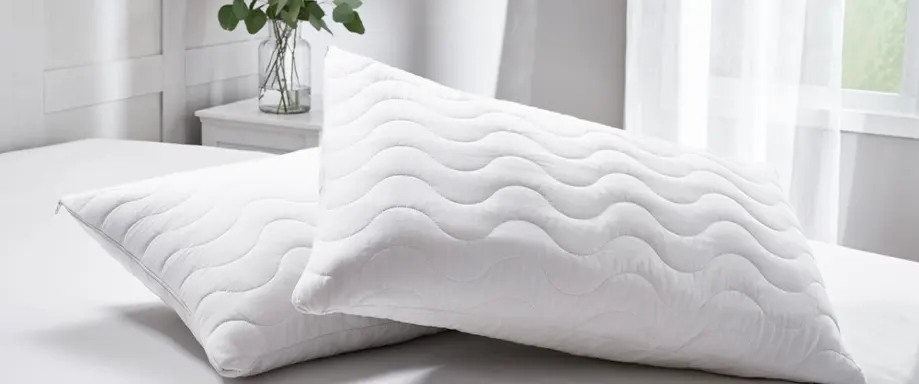












There are no comments yet
"*" indicates required fields